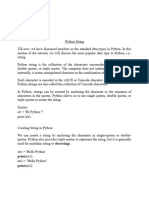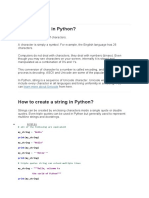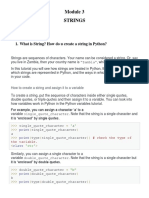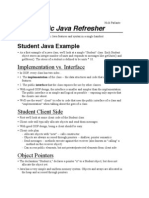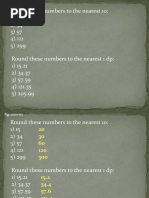Cs100 2014F Lecture 05 String Methods
Uploaded by
Faded RianbowCs100 2014F Lecture 05 String Methods
Uploaded by
Faded RianbowIntroduction to Computing Using Pytho
Methods on strings and
other things
Strings, revisited
Objects and their methods
Indexing and slicing
Some commonly used string methods
Introduction to Computing Using Pytho
Remember: What is a string?
A string is a sequence of zero or more
characters
A string is delimited by (begins and ends with)
single or double quotes
poem = 'Ode to a Nightingale'
lyric = "Roll on, Columbia, roll on"
exclamation = "That makes me !#? "
The empty string has zero characters ('' or
"")
Introduction to Computing Using Pytho
Quote characters in strings
You can include a single quote in a double
quoted string or a double quote in a single
quoted string
will = "All the world's a stage"
ben = 'BF: "A penny saved is a penny earned"'
To put a single quote in a single quoted string,
precede it with the backslash ('\') or 'escape'
character.
>>> will = 'All the world\'s a stage'
>>> print(will)
All the world's a stage
The same goes for double quotes
>>> ben = "BF: \"A penny saved is a penny earned\""
>>> print(ben)
Introduction to Computing Using Pytho
Putting a format character in
a string
A format character is interpreted by print() to
change the layout of text
To put a format character in a string, precede it
with the backslash ('\')
A newline is represented by '\n'
>>> juliette = 'Good night, good night\nParting is
such sweet sorrow'
>>> print(juliette)
Good night, good night
Parting is such sweet sorrow
A tab is represented by '\t'
>>> tabs = 'col0\tcol1\tcol2'
>>> print(tabs)
col0
col1
col2
Introduction to Computing Using Pytho
Index of string characters
The first character of a string has index 0
>>> greeting = 'hello, world'
>>> greeting[0]
'h'
>>> 'hello, world'[0]
'h'
You can also count back from the end of a
string, beginning with -1
>>> greeting = 'hello, world'
>>> greeting[-1]
'd'
>>> 'hello, world'[-1]
'd'
Introduction to Computing Using Pytho
Slicing a string
You can use indexes to slice a string
aStr[i:j] is the substring that begins with index
i and ends with (but does not include) index j
>>> greeting = 'hello, world'
>>> greeting[1:3]
'el'
>>> greeting[-3:-1]
'rl'
omit begin or end to mean 'as far as you can
go'
>>> print(greeting[:4], greeting[7:])
hell world
aStr[i:j:k] is the same, but takes only every kth character
>>> greeting[3:10:2]
Introduction to Computing Using Pytho
List index vs string index
How they're the same and how they're different
SAME:
You can index a list (or tuple), beginning
with 0 from the left or -1 from the right.
You can slice a list using begin and end
([i:j]) or begin, end and step ([i:j:k])
You can omit begin or end ([:j] or [i:]) to
mean 'as far as you can go'
Introduction to Computing Using Pytho
List index vs string index
(continued)
DIFFERENT:
if you take a single element of a list with
the index operator ([i]), its type is the type
of that element
>>> abc = ['a', 'b', 'c']
>>> abc[0]
'a'
>>> type(abc[0])
<class 'str'>
If you slice a list with begin and end ([i:j]),
you get a sublist (type list)
>>> abc[0:2]
['a', 'b']
>>> type(abc[0:2])
<class 'list'>
Introduction to Computing Using Pytho
String methods
A method is a function that is bundled
together with a particular type of object
A string method is a function that works on a
string object
This is the syntax of a method:
anObject.methodName(parameterList)
For example,
>>> 'avocado'.index('a')
0
returns the index of the first 'a' in 'avocado'
You can also use a variable of type string
>>> fruit = 'avocado'
>>> fruit.index('a')
0
Introduction to Computing Using Pytho
Method parameters
Like any function, a method may have zero or
more parameters
Even if the parameter list is empty, the
method still works on the 'calling' object:
>>> 's'.isupper()
False
Here is a string method that takes two
parameters:
>>> aStr = 'my cat is catatonic'
>>> aStr.replace('cat', 'dog')
'my dog is dogatonic'
Introduction to Computing Using Pytho
Strings are immutable
A string is immutable -- once created it can not
be modified
When a string method returns a string, it is a
different object; the original string is not
changed
>>>
>>>
>>>
'my
>>>
'my
aStr =
newStr
newStr
dog is
aStr
cat is
'my cat is catatonic'
= aStr.replace('cat', 'dog')
dogatonic'
catatonic'
However, you can associate the old string
name with the new object
>>> aStr = 'my cat is catatonic'
>>> aStr = aStr.replace('cat', 'dog')
>>> aStr
Introduction to Computing Using Pytho
Python string methods
Python has many very useful string methods
You should always look for and use an existing
string method before coding it again for
yourself. Here are some
s.capitalize()
s.count()
s.endswith() / s.startswith()
s.find() / s.index()
s.format()
s.isalpha()/s.isdigit()/s.islower()/s.isspace()
s.join()
s.lower() / s.upper()
s.replace()
s.split()
s.strip()
Introduction to Computing Using Pytho
Python string method
documentation
You can find the meaning of each of these
string methods in the Python documentation
String methods are in Python 3.3.0
documentation 4.7.1
Operations that strings in Python share with
other sequence types, both mutable and
immutable, are documented in 4.6.1. For
example:
x in s
x not in s
s + t
s*n / n*s
len(s)
min(s)
max(s)
Introduction to Computing Using Pytho
Strings and the print()
function
The print() function always prints a string. (Just
as the input() function always inputs a string.)
Every object in Python has a string
representation. Therefore, every object can be
printed.
When you print a number, a list or a function it
is the string representation of the object that is
printed
print() takes 0 or more arguments and prints
their string representations, separated by
spaces
>>> print('pi =', 3.14)
pi = 3.14
>>> def f():
Introduction to Computing Using Pytho
The print() separator and
end
By default, print() separates its outputs with
spaces
You can change this to any string that you
want, for example, a colon and a space (': ')
>>> print(1, 2, 3, sep=': ')
1: 2: 3
By default, print() ends its output with a
newline ('\n')
>>> for i in range(3):
print(i)
0
1
2
You can change this, for example, to a hyphen
>>>for i in range(3):
Introduction to Computing Using Pytho
The string format method
The string format() method allows you very
detailed control over what is printed and its
arrangement (including alignment; width; your
choice of date, time and number formats; and
many other things).
Here is an example of how s.format() can be
used to control what is printed:
>>> print('{} is {}'.format('Big Bird', 'yellow'))
Big Bird is yellow
>>> print('{} is {}'.format('Oscar', 'grumpy'))
Oscar is grumpy
You might also like
- Programming & Numerical Analysis: Kai-Feng ChenNo ratings yetProgramming & Numerical Analysis: Kai-Feng Chen46 pages
- 03.string - Manipulations - and - Boolean - Datatype - Jupyter NotebookNo ratings yet03.string - Manipulations - and - Boolean - Datatype - Jupyter Notebook46 pages
- Python Strings Cheat Sheet_169f7cd0d8218228197ae90af52ed81cNo ratings yetPython Strings Cheat Sheet_169f7cd0d8218228197ae90af52ed81c1 page
- Lecture 7 - Strings in Python With Examples - 1No ratings yetLecture 7 - Strings in Python With Examples - 110 pages
- 03_20240930_Strings_Collections-Data-TypesNo ratings yet03_20240930_Strings_Collections-Data-Types32 pages
- An Introduction To Python: Phil SpectorNo ratings yetAn Introduction To Python: Phil Spector26 pages
- Learn Python 3 - Strings Reference Guide - CodecademyNo ratings yetLearn Python 3 - Strings Reference Guide - Codecademy7 pages
- 3.string Slicing and Other Functions in PythonNo ratings yet3.string Slicing and Other Functions in Python4 pages
- 13-Strings - Understanding String in Build Methods and Operations (Slicing) - 12-04-2023No ratings yet13-Strings - Understanding String in Build Methods and Operations (Slicing) - 12-04-202317 pages
- IS-344 Computing Applications in Business Spring 2014 Week 80% (1)IS-344 Computing Applications in Business Spring 2014 Week 8132 pages
- IS-344 Computing Applications in Business Spring 2015 Week 7No ratings yetIS-344 Computing Applications in Business Spring 2015 Week 755 pages
- IS-344 Computing Applications in Business Spring 2015 Week 6No ratings yetIS-344 Computing Applications in Business Spring 2015 Week 6103 pages
- IS-344 Computing Applications in Business Spring 2015 Week 4No ratings yetIS-344 Computing Applications in Business Spring 2015 Week 445 pages
- IS-344 Computing Applications in Business Spring 2015 Week 5No ratings yetIS-344 Computing Applications in Business Spring 2015 Week 570 pages
- IS-344 Computing Applications in Business Spring 2015 Week 2No ratings yetIS-344 Computing Applications in Business Spring 2015 Week 243 pages
- IS-344 Computing Applications in Business Spring 2015 Week 1No ratings yetIS-344 Computing Applications in Business Spring 2015 Week 162 pages
- IS-344 Computing Applications in Business Spring 2015 Week 3No ratings yetIS-344 Computing Applications in Business Spring 2015 Week 3110 pages
- Exceptions (Oops! When Things Go Wrong) : Errors and Exceptions Syntax Errors State (Execution) ErrorsNo ratings yetExceptions (Oops! When Things Go Wrong) : Errors and Exceptions Syntax Errors State (Execution) Errors8 pages
- Dictionaries: Keeping Track of Pairs: Dict TupleNo ratings yetDictionaries: Keeping Track of Pairs: Dict Tuple10 pages
- More Looping Structures: While Continue BreakNo ratings yetMore Looping Structures: While Continue Break12 pages
- Group Practice in Problem Design and Problem Solving: in This Lesson, You Will ToNo ratings yetGroup Practice in Problem Design and Problem Solving: in This Lesson, You Will To9 pages
- MAT 037 - Chapter 1 - Number and Numbering SystemsNo ratings yetMAT 037 - Chapter 1 - Number and Numbering Systems20 pages
- Python Learn Python Regular Expressions FAST The Ultimate Crash Course To Learning The Basics of Python Regular Expressions - (Acodemy)100% (1)Python Learn Python Regular Expressions FAST The Ultimate Crash Course To Learning The Basics of Python Regular Expressions - (Acodemy)127 pages
- Electronics Fundamentals: Circuits, Devices and Applications - FloydNo ratings yetElectronics Fundamentals: Circuits, Devices and Applications - Floyd30 pages
- Tabla de Alcanos Alquenos Alquinos CompletoNo ratings yetTabla de Alcanos Alquenos Alquinos Completo6 pages
- Basic Si Unit: F Ma M A F M Pound Foot/ Sec M Pound X Sec Foot M Pound - Sec FootNo ratings yetBasic Si Unit: F Ma M A F M Pound Foot/ Sec M Pound X Sec Foot M Pound - Sec Foot3 pages
- Business Letter Punctuations and Styles - Gerona Florence Mae 1No ratings yetBusiness Letter Punctuations and Styles - Gerona Florence Mae 11 page
- Oops Concepts 2. Alv Reporting Using Classes 3. Alv Reporting Using Function Modules (2-3 HRS.)No ratings yetOops Concepts 2. Alv Reporting Using Classes 3. Alv Reporting Using Function Modules (2-3 HRS.)91 pages








